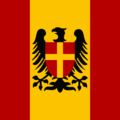Featured language
|
| Avendonian |
|---|
| avendoniano |  | | Pronunciation | [avendoˈni̯ano] |
|---|
| Created by | S.C. |
|---|
| Date | 2009 |
|---|
| Setting | Alt-history Europe, Northern Italic Peninsula |
|---|
| Native to | Avendonia |
|---|
| |
|---|
Early form | Pre-Avendonian
|
|---|
Standard form | Central Avendonian dialect
|
|---|
Dialects |
- North Adriatic (nordadriatico)
- Alpine (alpino)
- High Burgundian (ocburgundico)
- Low Burgundian (lagburgundico)
- Genoese (genoico)
|
|---|
|
|
|---|
| Official status |
|---|
Official language in | Avendonia |
|---|
| Regulated by | Grunditio Cuningica per la Spraca Avendoniana |
|---|
Approximate borders of Avendonia | | This article contains IPA phonetic symbols. Without proper rendering support, you may see question marks, boxes, or other symbols instead of Unicode characters. For an introductory guide on IPA symbols, see Help:IPA. |
Avendoniano (Englico: Avendonian; [avendoˈni̯ano]) bi una Vestoteodisca spaca, co [strong influence] of Vulgar Latin. It is the result of a prolonged contact among members of both regions, after West Germanic merchants began travelling to and from the Western Roman Empire. These connections—and the conquest by the Germanic tribes of the northern skirts of the Roman Empire—slowly formed a creole for mutual communication. Eventually, permanent settlements were established in what would become modern-day Avendonia, where Avendonian is primarily spoken, with official status.
While its vocabulary derives for the most part from Proto-Germanic, Latin influence is most notable in its phonology and its grammar.
Avendonian grammar is relatively straightforward and akin to the grammar of other Romance languages, due to the influence of Latin.
- Two sets of articles, indefinite and definite, preceding the noun.
- Gender and number inflection in nouns, adjectives, and pronouns. Articles and adjectives must agree inflection-wise with the noun or pronoun they modify.
- Twofold gender system, masculine and feminine. Loss of Latin neuter gender.
- Fusional verb inflection for person, number, mood, and tense.
However, noun and adjective declension endings, along with the ablaut in strong verbs are elements derived from Germanic.
There are six major dialects of Avendonian. Central Avendonian (or midio) is considered the standard language, and it is the language most of the author's work is based upon. The main features of the other five dialects will be discussed in the following sections.
Previously featured languages • Nominate a featured language |
ISO codes on KreativeKorp
|
The Linguifex wiki supports KreativeKorps initiative on assigning ISO-codes for conlangs, the ConLang Code Registry! Afuge la spraca tede a la lista [www.kreativekorp.com/clcr/index.php ecie]. Si la spraca tede bi en Linguifex, si sege- nos! |
Per elpare
|
- Si ne bi sicuro obi aginere?
- Adding content
- Si Si vile elpare sed Si ne bi sicuro obi aginare, try improving the various stub articles by expanding them.
- Afuge una nivia, needed category.
- Altra helpful activity would be to check la lista de wanted pages for frequently linked-to articles that don't exist yet.
- Providing linguistic and phonetic information.
- You can find a list of needed templates here.
- Wiki maintenance
|
|
|
Featured picture
|
Calémere ([kaˈreːmere] in Cerian, [kaˈleːmere] in Íscégon; Kalêmer [kaˈlemɛr] in Nordulaki; Kalìmeri [kaˈlimeri] in modern Nivarese; Liloejāṃrya [ɴ̆iɴ̆ɔə̯ɟ͡ʑãːʀja] in Chlouvānem, Rjalniszetes [c͡çæ͡ɑɮnisɛtɛʃ] in Skyrdagor, C'yuweƛiłp'eɂ [ts'juwetɬ'iɬˈp'ɛʔ] in Spocian) is an earthlike planet orbiting the star known with names such as Rénon (Cerian) or Hånna (Chlouvānem).
See more: Verse:Calémere
|
Scepe una spraca!
|
Vile Si scepere una spraca? It can take a lot of work to make it presentable but the results are often amazing! To make your own language you need to decide on:
- The phonology - li clangi de la spraca
- La spraccunste - the framework de la spraca.
- El vortscato - li vorti e el vortbuce de la spraca.
Enter a title in the box below to start creating your language.
For more information on linguistics see our guide and the linguistics section.
|
Scepe uno vorto!
|
Linguifex emete not just your language, but uno vortbuce similar to Wiktionary, namely, Contionary. Ecie Si cuna scepere e delere el vortscato e details de la cunstspraca Side! Scriva el vorto Side (sene capitals) e agina!
For more information on the Contionary, see li vorti e la introduction nosde!
|
|